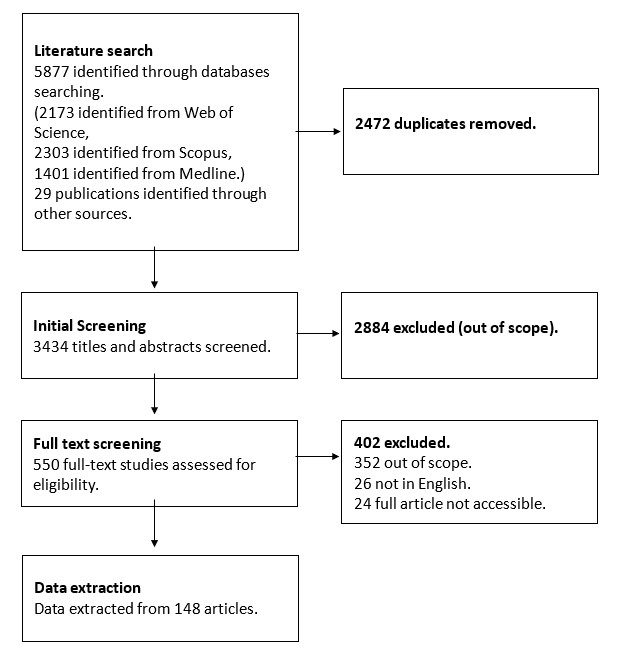Critical review of AMR risks arising as a consequence of using biocides and certain heavy metals in food animal production; Materials and methods
The materials and methods used in the study.
A systematic review approach was taken to the literature search (Figure 2). Because of the paucity of specific published studies on this topic a narrative critical review approach was taken to the review of the publications identified.
The review question was:
“Do biocides and/or heavy metals used in food animal production have an impact on the development of AMR in the food chain?”
The key elements of the question (PIO): Population (P), Intervention (I), and Outcome (O), were:
- The population of interest included pathogenic and non-pathogenic antimicrobial-resistant bacteria and their resistance genes. It excluded microorganisms other than bacteria, such as viruses, fungi, and parasites.
- All biocide or heavy metal interventions used in food animal production.
- Relevant outcome measures for interventions were, what impact did the intervention have on antimicrobial-resistant bacteria and ARGs and resistance.
The review adopted a comprehensive search strategy considering all available evidence in the public domain, including peer-reviewed articles, grey literature (for example, government and industry reports), relevant government reports (for example, FSA published studies, ACMSF reports), European and International literature (for example, the EFSA Scientific Opinions, WHO reports, SCENHIR) up to February 2023. This included previously published systematic and critical reviews, and risk assessments, as well as primary research.
The primary source databases searched were Web of Science, Scopus, and MEDLINE. These bibliographic databases are widely used and include food production, agriculture, public health, and food safety subject areas. The initial searches were restricted to records published from the 1st January 1990 to the 26th July 2022. Further searches were carried out during the course of the study to ensure the review was as ‘up to date’ as possible. The last search being carried out to identify any publications prior to 17th February 2023. The finalised keywords were agreed with the Food Standards Agency and were:
co-selection OR “antimicrobial resistance” OR “antimicrobial resistant” OR “antibiotic resistance” OR “antibiotic resistant” OR “drug resistant” OR “drug resistance” OR “multidrug resistant” OR “multidrug resistance” OR “multi resistance” OR “multi resistant” OR ABR OR AMR OR MDR OR MAR OR AMRG
AND
antiseptic OR biocide* OR disinfectant* OR sanitizer* OR sanitiser* OR “essential oil*” OR “heavy metal*” OR antifouling
AND
“food animal production” OR fish OR seafood OR aquaculture OR salmon OR trout OR cow OR cattle OR dairy OR pig OR swine OR sheep OR lamb OR poultry OR chicken OR turkey OR livestock OR food OR manure OR fertiliser OR feed OR crop* OR “ground water” OR soil OR bedding
Focused Google and Google Scholar searches were used to identify relevant grey literature.
A total of 5,877 citations were initially identified of which 2,173 citations were identified in Web of Science, 2,303 in Scopus and 1,401 in MEDLINE. There was considerable overlap between the databases with 2,472 duplicates leaving 3,405. An additional 29 records were identified through focused Google and Google Scholar searches, searching within relevant publications, and through contact with authors. For all searches, citations and abstracts were uploaded from each of the electronic databases into Covidence (an online tool for systematic reviewing). The following exclusion criteria were applied:
- They contained no relevant data on the impact of biocides and/or heavy metals used in food animal production on the development of AMR.
- Measured irrelevant population (viruses, fungi, and parasites), interventions (biocide not used in food animal production [for example, healthcare]; used for their surfactant properties, antimicrobial peptides [for instance, bacteriocins]; or undesirable heavy metals (such as arsenic [As], cadmium [Cd], mercury [Hg], lead [Pb]), outcomes (did not include impact on antimicrobial-resistant bacteria or genes).
- Were in a language other than English.
The criteria were independently applied to the abstract of each paper by at least two members of the five-member project team. For each citation, a consensus was reached that the citation is relevant for inclusion. Arbitration by a third member of the project team was used to settle conflicting appraisals. A total of 3,434 titles and abstracts were screened, and 2,884 references excluded. Full texts were obtained for all abstracts that passed the inclusion criteria.
A total of 550 publications were considered relevant by title and abstract and full texts collected for second screening. This number was reduced to 148 publications from which some data were extracted, with 402 articles being excluded because they were not in English, the full article was not accessible, or the article was out of scope. An in-depth content analysis of the selected articles was carried out. With the key elements of interest from each paper extracted. To synthesise the data extracted and evaluate its quality a narrative approach was used. This was used to: a) develop a synthesis of findings of the studies, b) investigate relationships within and between studies, and c), evaluate the degree of robustness of the synthesis.
Figure 2: Flow diagram of the selection and exclusion of articles related to the scope of this review.
